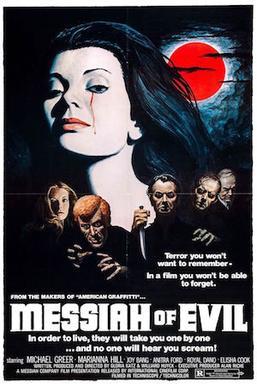It’s polarizing. Even now, nearing fifty, Messiah of Evil is either adored or excoriated. So it was at its release. I was pointed to the movie by an adorer—a somewhat unexpected New York Times seasonal article. Suggesting that there’s nothing else like it, the article recommended it for autumnal viewing. So, what’s it all about? I’m not really sure, but that won’t stop me from trying. Arletty is a young woman who wants to find her father (with you so far). He’s moved to New Bethlehem, California, now known as Port Dome. She finds his house abandoned, and the locals decidedly unfriendly. Her father’s diary explains that he’s transforming into something inhuman. The locals are cannibals, it turns out, awaiting the return of, well, the messiah of evil. (The title is never used in the movie.)

Although I learn more towards the excoriating opinion of things, this is a great horror and religion film. The original messiah of evil was a preacher stranded with the Donner party. He started a new religion and, wanting to spread it, went to California. Now, whenever a blood moon comes, he arises from the sea and his followers become aggressive. The movie is set a century following this first appearance, and the dark master is due to return. His followers await him on the beach, and Arletty is their intended sacrifice. Elements of Lovecraft are clearly evident—people transforming, old gods, evil emerging from the ocean. Yet, there are many things unexplained. Or maybe I’m just naive.
The male lead, Thom, travels with a mini-harem. He’s in Port Dume because he likes to gather folktales—like the blood moon—and he likes Arletty’s father’s art and came to buy some locally. The movie features a blind art dealer, cops who apparently know nothing about the infestation of ghouls in their town, and a guy who could drive away from the attacking hordes who decides to run instead. The directors (Willard Huyck and Gloria Katz) were a talented couple, but this wasn’t their best collaboration. Still, many recommend this as an overlooked horror gem from decades ago. Others not so much. I’m glad to have seen it, although I fall into the latter camp. Mainly because it continues a theme that I’ve tried to pick up at several points on this blog—that horror and religion have a great deal in common. Even if one (or both) shows its age and fails to impress.
